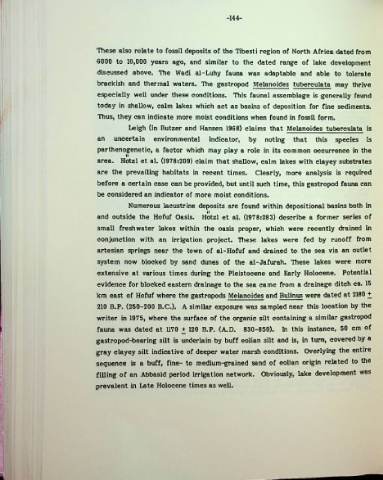Page 168 - Life & Land Use on the Bahrain Islands (Curtis E Larsen)
P. 168
-144-
These also relate to fossil deposits of the Tibesti region of North Africa dated from
6000 to 10,000 years ago, and similar to the dated range of lake development
discussed above. The Wadi al-Luhy fauna was adaptable and able to tolerate
brackish and thermal waters. The gastropod Melanoides tuberculata may thrive
especially well under these conditions. This faunal assemblage is generally found
today in shallow, calm lakes which act as basins of deposition for fine sediments.
Thus, they can indicate more moist conditions when found in fossil form.
Leigh (in Butzer and Hansen 1968) claims that Melanoides tuberculata is
an uncertain environmental indicator, by noting that this species is
parthenogenetic, a factor which may play a role in its common occurrence in the
ti
area. Hotzl et al. (1978:209) claim that shallow, calm lakes with clayey substrates
are the prevailing habitats in recent times. Clearly, more analysis is required
before a certain case can be provided, but until such time, this gastropod fauna can
be considered an indicator of more moist conditions.
Numerous lacustrine deposits are found within depositional basins both in
ii
and outside the Hofuf Oasis. Hotzl et al. (1978:283) describe a former series of
small freshwater lakes within the oasis proper, which were recently drained in
conjunction with an irrigation project. Ttiese lakes were fed by runoff from
artesian springs near the town of al-Hofuf and drained to the sea via an outlet
system now blocked by sand dunes of the al-Jafurah. TTiese lakes were more
extensive at various times during the Pleistocene and Early Holocene. Potential
evidence for blocked eastern drainage to the sea came from a drainage ditch ca. 15
km east of Hofuf where the gastropods Melanoides and Bulinus were dated at 2180 +
210 B.P. (250-200 B.C.). A similar exposure was sampled near this location by the
writer in 1975, where the surface of the organic silt containing a similar gastropod
fauna was dated at 1170 + 120 B.P. (A.D. 830-850). In this instance, 50 cm of
gastropod-bearing silt is underlain by buff eolian silt and is, in turn, covered by a
gray clayey silt indicative of deeper water marsh conditions. Overlying the entire
sequence is a buff, fine- to medium-grained sand of eolian origin related to the
filling of an Abbasid period irrigation network. Obviously, lake development was
prevalent in Late Holocene times as well.
A

